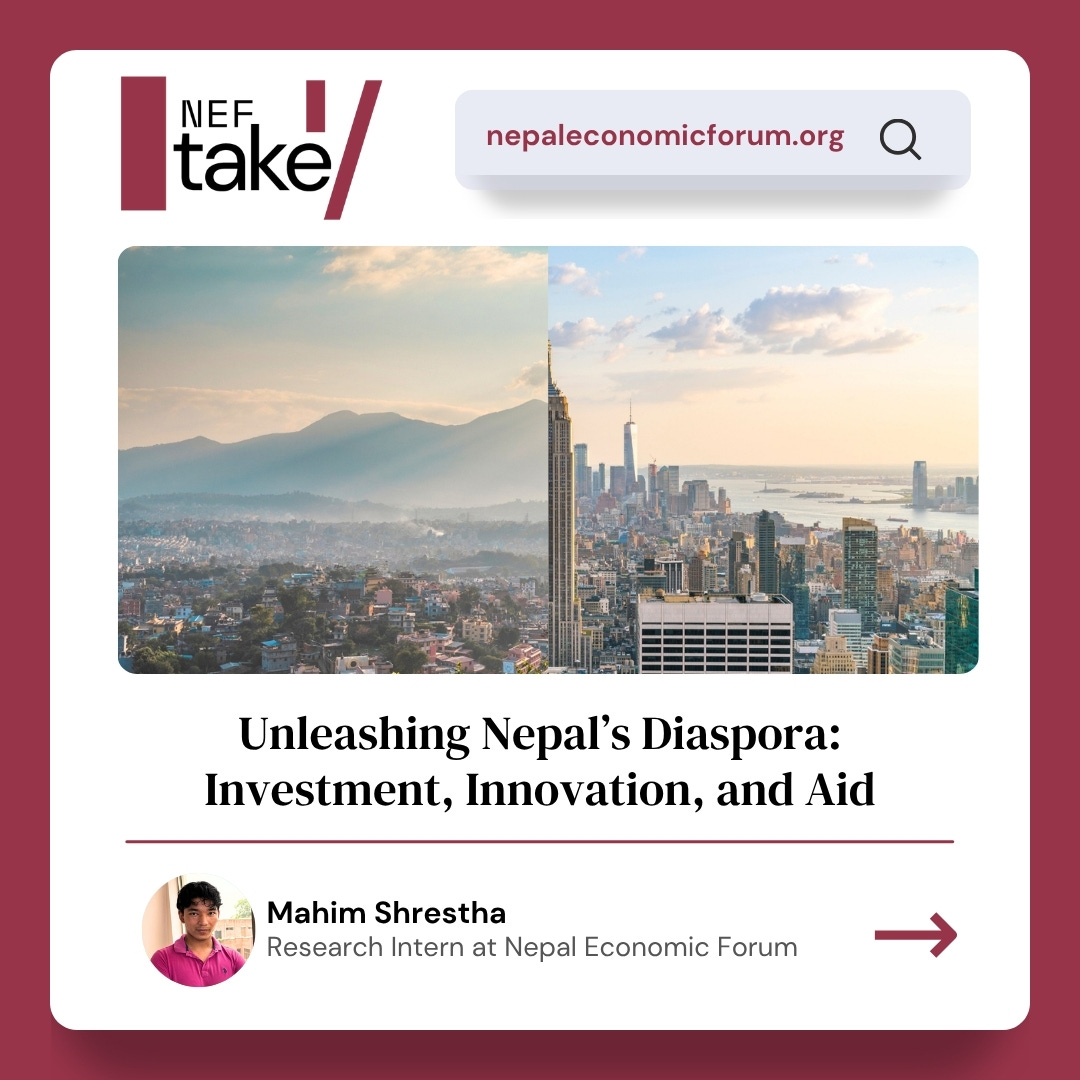Greetings from Nepal Economic Forum!
Missed the launch of the United Nations Development Programme’s (UNDP’s) Nepal launch of the Human Development Report (HDR) 2025? We’ve got you covered. The full proceedings report is now live! Read it now to dive into key insights and takeaways from the launch, which brought together leading voices to discuss how Nepal can advance human development, especially amidst the rapid growth of Artificial Intelligence (AI).
Also in this issue: How can Nepal better engage its global diaspora beyond remittances? In this week’s NEFtake, Mahim Shrestha examines the broader contributions of diaspora communities, from impact investment to innovation, and outlines the policy frameworks needed to unlock their full potential. Scroll to read the full article.
And don’t miss Sujeev Shakya’s latest NEFview on his reflections from his Europe visit, which included speaking at Le Cercle des économistes.
Scroll down to explore more!
Weekly Economic Update | July 4 - July 11, 2025
What are the top 10 economic news stories of the week for Nepal? For the full list with sources, click here or on the image below.
Weekly NEFview | A View from Europe: Navigating Labor Crises, Migration Attitudes, and Missed Connections
What can a quiet dinner in the Netherlands reveal about Europe's labor crisis and its global implications?
In this week’s NEFview, Sujeev Shakya explores how worker shortages, anti-migration sentiments, and colonial legacies are reshaping Europe’s relationship with the rest of the world, based on his experiences at the Le Cercle des économistes.
Click here or on the picture below to read now!
Weekly NEFtake | Unleashing Nepal’s Diaspora: Investment, Innovation, and Aid
Nepal’s diaspora refers to people of Nepali origin living outside Nepal, including both long-term emigrants who have adopted new nationalities and migrant workers temporarily employed abroad. This diverse group spans everyone from Gulf-based labor migrants to second-generation professionals in the United States and Europe. While the term “diaspora” is often used broadly, Nepal’s legal framework offers a more specific designation: under the Non-Resident Nepali (NRN) Act 2008, an NRN is defined as either (a) a Nepali citizen who has lived abroad continuously for at least two years, or (b) a foreign citizen of Nepali origin. Registered NRNs receive special identification cards that grant the right to invest, own certain property, and access various incentives.
The importance of this community is undeniable. Official estimates count about 2.19 million Nepali citizens residing overseas, but when including foreign citizens of Nepali origin, the true size of the diaspora is much larger. While many longer-settled diaspora households contribute through investment, tourism, and philanthropy, most remittances come from short-term migrant workers employed abroad, particularly in Gulf countries and Malaysia. According to Nepal Rastra Bank (NRB), in the first ten months of fiscal year 2024/25 AD (2081/82 BS), remittances reached NPR 1.36 trillion (approximately USD 9.96 billion), a 13.2% rise from the previous year. These transfers remain Nepal’s largest source of foreign currency and a critical pillar of household income and reserves.
While remittance flows; Nepal’s largest source of foreign currency, come mostly from migrant workers, the broader diaspora also contributes skills, networks, and investment. Nepal can move beyond reliance on remittances to harness this potential, reviewing current policies, examples of diaspora engagement, and recommendations for deeper collaboration.
Engaging the Diaspora: Policies and Incentives
The Government of Nepal has taken a series of steps to tap Nepali global talent. The foundation of these steps was established in 2008 with the landmark legislation of the NRN Act 2064 recognizing the diaspora as a national resource and grating NRNs key rights such as the ability to invest in Nepal and the right to repatriate capital and profits. As per the act, NRNs are also allowed to purchase and hold land, subject to certain limits, and can obtain special identity cards and multi‐entry visas to streamline travel and business. In practice, the government has even created a “one-stop service” center for investment proposals and eased the bureaucratic hurdles for foreign investors.
To attract diaspora capital, Nepal offers incentives such as:
Tax holidays and exemptions: NRN investors in priority sectors like hydropower, tourism or manufacturing can enjoy up to 7 years of income-tax holidays.
Duty-free imports: Machinery and equipment brought in by NRNs for projects can clear customs without duty.
Simplified visas: Nepalis abroad can obtain extended, multiple-entry business visas and citizenship-transit visas to facilitate business travel.
Land purchase rights: Foreign Citizens of Nepali Origin can buy limited residential land in Nepal
Repatriation rights: NRNs can repatriate profits, dividends, and proceeds from the sale of shares or investments, provided prior approval is obtained and taxes are settled.
Exemptions on property inheritance: NRNs can inherit ancestral property without requiring special approval, provided they hold an NRN ID card.
Investment thresholds exemption: For NRNs, some investment approval thresholds under FITTA (such as minimum capital requirements) can be waived or simplified compared to other foreign investors.
Tax deductions on donations: NRNs donating to not-for-profit entities in Nepal can deduct contributions up to NPR 100,000 or 5% of taxable income (whichever is less), if they are tax residents.
Fast-track approvals for priority sectors: NRN investments in designated industries can get simplified approvals and clearances through the Investment Board Nepal.
In practice, these changes mean NRN investors now operate with near parity to locals. Recent amendments have further bolstered this by allowing NRNs to invest in Nepal’s stock market. In late 2024, the Securities Board of Nepal (SEBON) authorized new “joint investment companies” that can float Initial Public Offerings (IPOs) especially for NRNs. These firms must issue between 10% and 49% of their shares to NRN subscribers, who can buy and trade them among themselves with a one-year lock-in.
Perhaps most importantly, a “Nepal Development Fund” (NDF) has been created to channel diaspora savings into Nepal’s infrastructure and industry. In 2024, the Non-Resident Nepali Association (NRNA) launched this NDF with a paid-up capital of NPR 10 billion, of which the Government of Nepal holds 5%. It is structured so that up to NPR 8.5 billion (85% of its capital) can be raised via a public IPO exclusively for NRN subscribers. In other words, only Nepalis abroad or of Nepali origin can apply for these shares in the NDF, effectively pooling diaspora funds for national development. This fund is intended for large projects, with an initial target on hydropower and infrastructure sectors where diaspora expertise and social impact can be significant.
Other channels are also expanding. NRNs in recent years have been allowed to open specialized accounts such as:
NRN Rupee Accounts: Local-currency accounts that can be funded by remittances or local income and used for investment in Nepal.
NRN Foreign-Currency Accounts: Accounts held in USD/EUR/GBP, simplifying deposits from abroad without immediate conversion.
Foreign Currency Investment Account: Dedicated accounts through which NRNs can directly invest in approved sectors in Nepal, simplifying capital transfers.
These account schemes ensure that NRN money can flow securely and transparently into local banks and projects. In short, Nepal now tries to treat its overseas Nepalis almost like domestic partners. Overall, the legal framework provides special considerations for NRNs that aren’t available to other foreign investors especially regarding land ownership, investment thresholds, and repatriation rights.
Diaspora Philanthropy and Disaster Response
Beyond investment, Nepal’s diaspora also plays a crucial humanitarian role. This was most evident in 2015, when the Gorkha earthquakes devastated much of Nepal and diaspora communities worldwide immediately mobilized relief. Student groups and NRN chapters raised funds and gathered supplies. For example, within weeks of the earthquake the MIT Group, run by diaspora leaders Shesh Ghale and Jamuna Gurung, alone donated AUD 250,000 (NPR 22 million) to relief. Across Europe, North America and Asia, Nepali expatriates organized benefit concerts, fundraisers, and online campaigns to support earthquake survivors. Diaspora-led NGOs also filled gaps in the years of reconstruction. This pattern repeated in later emergencies as well. During the COVID-19 crisis in 2020-21, Nepali associations overseas collected medical supplies and raised money for hospitals. In 2021, NRN chapters in Gulf countries donated oxygen cylinders and PPE to Nepal’s hospitals, often coordinated through the International Labor Organization (ILO)-funded “COVID-19 Response for Migrant Workers” program of the NRNA.
In between crises, diaspora philanthropy also takes the form of scholarships, cultural exchanges and mentorship. For example, Help Nepal Network, a global charity run by Nepalis abroad, has funded libraries and schools in more than 50 districts. The America Nepal Medical Foundation regularly provides training and equipment to rural health centers. Diaspora media and networks, such as the Non-Resident Nepali Association’s online forums, have been instrumental in spreading awareness of Nepal’s challenges, sharing success stories, and organizing crowdfunding for community projects.
Looking Ahead: A Diaspora-Driven Future
Nepal stands at a crossroads where it can further transform remittances and goodwill into lasting development. The evolving “diaspora narrative” is encouraging as younger Nepalis abroad increasingly focus on enterprise over politics. Today’s diaspora is less about old-timers waving party flags, and more about entrepreneurs and social media-savvy youth with “big dreams and ambitions.” To fully harness this potential, Nepal should deepen diaspora engagement with policies and technology. This could include expanding the NDF model to sector-specific funds like tourism, tech start-ups etc., further liberalizing investment rules, and actively matchmaking diaspora skills to domestic needs. For example, diaspora data scientists could collaborate on Nepal’s digital economy, or Nepali-origin doctors abroad could support telemedicine projects. Reducing remittances transfer costs could also make a difference since fees currently average 4-5% of each transaction; lowering them would keep more income in Nepali households and the formal financial system. Finally, it will be crucial to create stronger and more organized diaspora networks that can connect people and channel resources effectively. For instance, The Global Nepali Diaspora (TGND) platform has begun to connect professionals across continents, helping Nepali entrepreneurs to find mentors and partners for new ventures.
The recent trend is positive: regulators are actively “clearing hurdles” to NRN investment, and Nepali officials now openly state that diaspora capital is welcome in sectors from hydropower to IT. As Sujeev Shakya puts it, “in the long run, Nepalis will not only do well in the US but also become catalysts in transforming Nepal’s journey”. However, it is important to recognize that this potential does not come without obstacles. Many diaspora investors still face bureaucratic delays and policy uncertainty. Even promising initiatives like the Nepal Development Fund have been slow to gain momentum because of limited outreach. With nearly a third of its GDP coming from abroad, Nepal cannot afford to overlook this asset. By expanding legal pathways and building bridges to its two million plus nationals overseas, Nepal can unleash a powerful engine of growth from investments and innovation to aid when disaster strikes.
That is all for this week! For more informational posts every day, follow us on social media on the following handles:
Instagram | Facebook | Twitter | LinkedIn | YouTube
We hope you enjoyed this newsletter. Do let us know what you think about it through this short form!
Best,
Nepal Economic Forum






